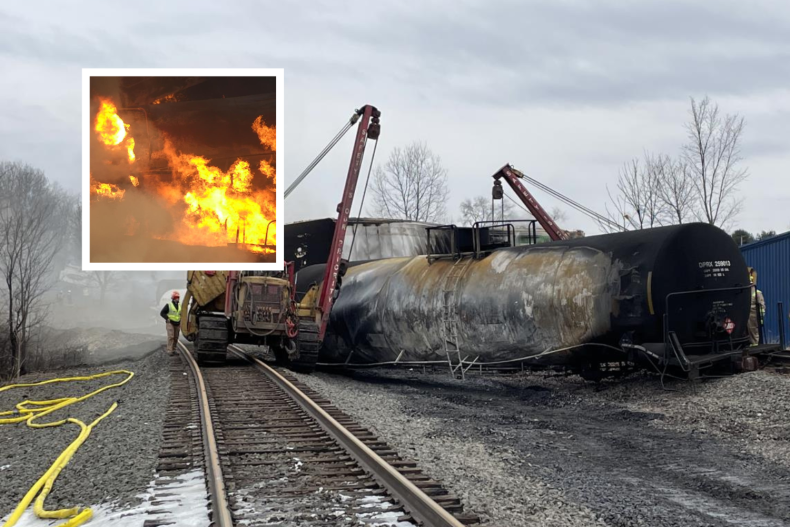Lingering Effects: Toxic Chemicals In Buildings After Ohio Train Derailment

Table of Contents
Contamination Pathways: How Toxic Chemicals Spread to Buildings
The toxic chemicals released, including vinyl chloride, butyl acrylate, and others, spread through various pathways, contaminating buildings in the vicinity of the derailment. Understanding these pathways is critical for effective remediation.
-
Airborne Dispersal: Volatile organic compounds (VOCs) like vinyl chloride are easily aerosolized and can travel considerable distances on the wind. These VOCs can settle on building surfaces, both exterior and interior, leading to long-term exposure through inhalation. The health effects from chronic inhalation of vinyl chloride include liver damage, increased cancer risk, and neurological problems.
-
Groundwater Contamination: Chemicals can leach into the soil, contaminating groundwater sources. This poses a significant risk to buildings whose foundations are in contact with contaminated soil or that rely on wells for water. Groundwater contamination can lead to the infiltration of toxic chemicals into basements and lower levels through cracks or other openings. This requires thorough testing and potentially extensive remediation.
-
Surface Runoff: Rainwater can act as a vector, transporting chemicals from contaminated soil and debris onto building exteriors. Many of these chemicals are persistent, meaning they don't readily break down, potentially leading to long-term contamination and the need for surface cleaning and decontamination.
Identifying and Assessing the Extent of Contamination
Accurately assessing the extent of contamination within buildings is crucial for effective remediation. This requires employing various testing methods performed by qualified environmental professionals.
-
Air quality testing: This involves measuring the concentrations of VOCs and other airborne contaminants inside buildings. Advanced techniques can identify specific chemicals and assess their levels to determine the risk to occupants.
-
Soil sampling: Analyzing soil samples around buildings provides insights into the level of ground contamination and the potential for further infiltration. This is particularly important for identifying potential pathways of entry into buildings.
-
Water testing: Testing well water or municipal water supplies is crucial to determine whether contamination has reached drinking water sources, posing a serious health risk.
-
Wipe sampling: This method involves wiping surfaces with a special material and then testing the material for the presence of toxic chemicals. This helps identify surface contamination, particularly in areas with potential contact by occupants.
Remediation and Mitigation Strategies for Contaminated Buildings
Once contamination is identified, implementing effective remediation strategies is paramount. The approach depends on the extent and nature of the contamination, and should always be conducted by professionals adhering to strict safety regulations.
-
Decontamination and cleaning of surfaces: This involves physically removing or neutralizing toxic chemicals from surfaces through specialized cleaning techniques.
-
Air filtration and ventilation systems: High-efficiency particulate air (HEPA) filters and improved ventilation can help remove airborne contaminants and reduce indoor exposure.
-
Soil remediation: If soil contamination is significant, remediation may involve excavation and removal of contaminated soil, or in-situ treatment methods to neutralize the contaminants.
-
Water treatment systems: Contaminated well water may require treatment using filtration systems or other methods to remove toxic chemicals before consumption.
-
Building demolition: In severe cases where contamination is extensive and remediation is impractical or cost-prohibitive, building demolition may be the only viable option.
Long-Term Health Impacts and Safety Concerns
Exposure to the toxic chemicals released during the derailment, even at low levels, can have significant long-term health consequences. The specific health impacts vary depending on the chemical involved and the duration and level of exposure. These include respiratory problems, neurological disorders, increased cancer risk, and other serious health issues. Ongoing monitoring and health screenings for residents are essential to track potential long-term health effects.
Conclusion: Understanding the Lingering Effects of Toxic Chemicals – A Call to Action
The Ohio train derailment underscores the devastating and lingering effects of toxic chemicals on the environment and the built environment. Thorough testing, appropriate remediation strategies, and ongoing monitoring are crucial for protecting public health and ensuring the safety of buildings in affected areas. We must prioritize responsible environmental practices and regulations to prevent similar incidents in the future.
We urge residents in affected areas to learn more about the situation, contact local authorities or environmental agencies for information regarding building testing and remediation, and stay informed about ongoing efforts to address the impact of toxic chemicals from the Ohio train derailment. Don't hesitate to seek professional assistance if you suspect your building may be contaminated. Your health and safety are paramount.

Featured Posts
-
 Individual Investors And Market Swings Opportunities And Risks
Apr 28, 2025
Individual Investors And Market Swings Opportunities And Risks
Apr 28, 2025 -
 Nuclear Talks U S And Iran Remain Divided After Recent Discussions
Apr 28, 2025
Nuclear Talks U S And Iran Remain Divided After Recent Discussions
Apr 28, 2025 -
 Analyzing The Headwinds Why Luxury Car Brands Face Challenges In China
Apr 28, 2025
Analyzing The Headwinds Why Luxury Car Brands Face Challenges In China
Apr 28, 2025 -
 The China Factor How Its Affecting Luxury Car Brands Like Bmw And Porsche
Apr 28, 2025
The China Factor How Its Affecting Luxury Car Brands Like Bmw And Porsche
Apr 28, 2025 -
 Dissecting The Arguments Of Luigi Mangiones Supporters
Apr 28, 2025
Dissecting The Arguments Of Luigi Mangiones Supporters
Apr 28, 2025
Latest Posts
-
 Hudsons Bay Store Closing Sale Find Amazing Deals Now
Apr 28, 2025
Hudsons Bay Store Closing Sale Find Amazing Deals Now
Apr 28, 2025 -
 Alberta Economy Suffers Dow Megaproject Delay Amid Tariff Disputes
Apr 28, 2025
Alberta Economy Suffers Dow Megaproject Delay Amid Tariff Disputes
Apr 28, 2025 -
 Final Days Of Hudsons Bay 70 Off Liquidation Event
Apr 28, 2025
Final Days Of Hudsons Bay 70 Off Liquidation Event
Apr 28, 2025 -
 Hudsons Bay Closing Sale Deep Discounts On Remaining Inventory
Apr 28, 2025
Hudsons Bay Closing Sale Deep Discounts On Remaining Inventory
Apr 28, 2025 -
 Hudsons Bay Liquidation Up To 70 Off At Final Stores
Apr 28, 2025
Hudsons Bay Liquidation Up To 70 Off At Final Stores
Apr 28, 2025
